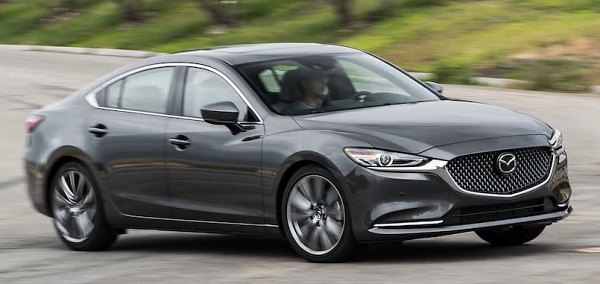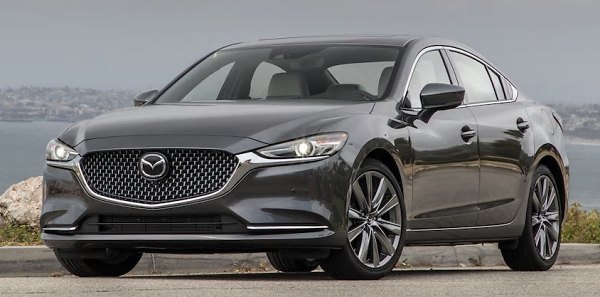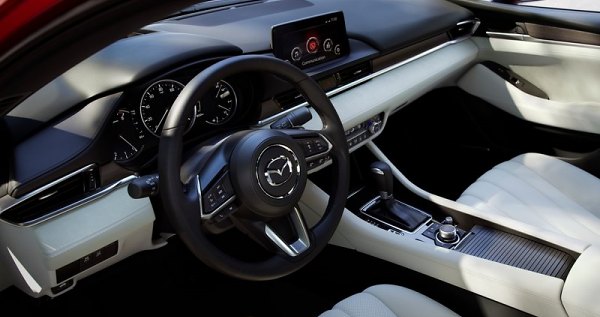Published
on 29
Oct 2012
|
All rights reserved.
|
|
|
We are biased
towards special
cars, no matter they work or not. Think about it: if all cars in the
world are built like Camry or Accord, will our motoring lives be as
colorful as today? Fortunately, there are companies like Mazda and
Subaru dare
to be
different. Don't get me wrong, the new Mazda 6 employs neither rotary
engines nor gullwing doors, but by family car standards it is unusual.
Its exterior design, engines and chassis are all built out of
philosophies very different from its mainstream rivals. No matter what
the results are, its radical thinking is already worth our admiration.
The radical thinking can be seen from a host of innovative technologies
called "Skyactiv". These
include efficient engines, lightweight chassis and others,
but it is best demonstrated by the new regenerative braking system
called i-Eloop. While other manufacturers use expensive absorption
glass matt battery to store the high electric current regenerated from
braking, Mazda employs super-capacitor and the existing lead-acid
battery to do the same job, hence saving weight and money.
The unusual character is also evident from the styling. A prominent,
in-your-face front grille ignores the conventional wisdom that tells us
the best selling family cars must be inoffensive. In conjunction with
aggressive headlights and strongly flowing front fenders, the
Mazda 6 looks like a leopard ready to launch a powerful attack on his
quarry. It brings a vibrant – or even unsettling –
atmosphere that you won't feel from its rivals. Meanwhile, its
unusually long bonnet makes it look like a
rear-wheel-drive machine, which should delight keen drivers. This
visual effect is implemented by turning the front grille upright and
pushing back the A-pillars by 100 mm – or the same tricks that Mercedes
applied to its new A-class. Mazda wants to make the 6 a poor
man's BMW.
The side view of the new car is the most beautiful, because you can see
a sleek, "4-door-coupe" proportion. Its C-pillars are so steeply raked
that you might
wonder how much headroom is left for the rear passengers (don't worry,
you'll see later). Compare with the outgoing generation, the new Mazda
6 looks so much slimmer, lighter and sportier. It is also more slippery
through the air, as shown by the drag coefficient of 0.26.
Having said that, its exterior design is far from perfect. It has too
many
rough edges, such as the fog lamp assemblies, the lower intake and
probably the whole tail. They are compromised for production
feasibility and cost control. If you look back to the 2010 Shinari
concept and the 2011 Takeri concept that foreran this car, you will see
the production 6 has lost a lot of opportunities. Its shape could have
been more adventurous and its details could have been more stylish. The
basic elements are carried over from the Takeri, but some subtle
changes of curvature and reworked details downgrade the visual appeal
considerably. Perhaps Mazda should consult Jaguar's Ian Callum how to
make production cars true to the concepts.
The outgoing Mazda 6 offered two versions: a smaller global version and
a larger American version. The former was built at its home factory in
Hiroshima and the latter was assembled at the Flat Rock plant in
Michigan, which was a 50-50 joint-venture with Ford. Now Mazda is no
longer tied to Ford and, naturally, the new 6 is to be produced
exclusively in
Hiroshima. As a result, it can no longer offer two markedly different
versions. American motorists will get the same car as those in Japan
and Europe, except different choices of engines and slightly different
suspension tuning. However, to meet the needs of American, the new
sedan is sized to be one of the largest in its segment. In other words,
it is a lot larger than the old global version, and close to the old
American version:
|
New Mazda 6
|
Old Mazda 6 (global)
|
Old Mazda 6 (USA)
|
Length
|
4865 mm
|
4735 mm
|
4920 mm
|
Width
|
1840 mm
|
1795 mm
|
1840 mm
|
Height
|
1450 mm
|
1440 mm
|
1470 mm
|
Wheelbase
|
2830 mm
|
2725 mm
|
2790 mm
|
Strangely, the wagon version is more compact than
the sedan, with 80 mm shorter wheelbase and 65 mm shorter length. Why?
Because Mazda sees America will be the largest
market for the sedan while Europe and Japan will snap up the majority
of the wagon. Therefore they are sized differently.
These days all rivals talk about weight reduction. However, most of
them resort to high-strength steel. Mazda is different. Not only lifted
the use of high and ultra-high strength steel from 40 to 60 percent of
the
chassis, it goes as far as modifying the chassis structure,
strengthening the central tunnel and relocating the load paths so that
it can cut unnecessary materials elsewhere without affecting crash
worthiness. It also tune the acoustic properties of the chassis so that
it can reduce the use of sound deadening materials. As a result, the
body-in-white is lightened by 8 percent while torsional rigidity is
lifted by 30 percent from the old model. In addition to other weight
saving measures, the new Mazda 6 is about 50 kg lighter than the old
compact version, even though it is a lot larger, and about 140 kg less
than the old American version. Compare with its current rivals, it is
about 100-150 kg lighter. That makes a difference in acceleration and
handling.
The Skyactiv-G
(gasoline) and Skyactiv-D (diesel) engines it used are even more
innovative. The former utilizes long 4-2-1 exhaust manifolds,
high-pressure direct injection and special pistons to enable an
unusually high compression ratio of 14.0:1, lifting power and torque
output. Take the Skyactiv-G 2.0-liter for example, it pumps out a
remarkable 165
horsepower and 155 pound-foot of torque yet
returns excellent fuel economy and emission. Another Skyactiv-G engine
is a 2.5-liter four-cylinder, primarily destined to the America. Its
compression ratio is a little lower at 13.0:1 as it needs to be
compatible with regular (91 RON) fuel, but still it produces a
remarkable 192 hp and 189 lbft. Moreover, the maximum torque needs no
more than 3250 rpm to realize, guaranteeing good tractability. Mazda
found an alternative solution to modern turbocharged engines.
Even better is the 2.2-liter Skyactiv-D turbo diesel. It offers two
states of tune – 150 hp / 280 lbft or 175 hp / 310 lbft. Contrary to
the petrol, it employs the lowest ever compression ratio (14.0:1) for
diesel engines. The lower pressure in combustion chambers
results in less NOx formation thus allows the engine to comply with
Euro
6 and US standards without resorting to expensive urea (adblue)
after-treatment. Moreover, due to the reduced stress it can switch to
aluminum head and block, lighten the pistons, con-rods, crankshaft and
uses smaller bearings. These result in a saving of more than 30 kg and
20 percent of friction. Reduced compression would have led to lower
combustion temperature hence misfire during cold start, so Mazda
employs
variable valve lift to open exhaust valves during intake
stroke, drawing hot exhaust gas back to the combustion chambers and
lifting temperature. Besides, piezo injectors are employed to enable up
to
9 injections during each combustion cycle to keep temperature under
control. Finally, a two-stage sequential twin-turbo system (with a
small turbo and a larger turbo connected in stage) ensures quick spool
up and high output simultaneously.
In reality, the 2.2 Skyactiv-D engine is a gem. It revs like a petrol
engine thanks to the lighter reciprocating parts. Redline is unusually
high at 5200 rpm. Power delivery is smooth and responsive. Its strong
torque and flexibility leave you no regret for the demise of V6 engine.
The only downside is a little more diesel clatter at startup and when
you push it hard, which means it is not the most refined diesel in
Europe. This is a diesel engine for the enthusiasts.
Annoyingly, Mazda also dubs the 6-speed manual and 6-speed automatic
transmission as "Skyactiv" technology. Their designs are actually
conventional. However, keen drivers will be delighted with both units –
the manual has a slick, short-throw and mechanical-feeling gearshift
like
that of the MX-5, while the torque-converter automatic is smooth,
responsive and clever. They are simply the best of the class.
Unfortunately, the chassis dynamics are not as good as the powertrain.
While the car feels light and responsive to steer, its strut
and multi-link suspension rides unexpectedly firm, especially on
19-inch wheels. This sporting flavor
is similar to Ford Fusion but without the latter's compliance. On rough
surfaces the ride could be harsh and noisy. Yes, noise is an issue in
the cabin. Mazda has reduced sound deadening to the extent that the
cabin can hear noticeably more suspension, road and engine noise than
its main competitors. If you look for comfort and refinement, you had
better to avoid this car.
The new electrical power steering is also disappointing. Quick and
precise it might be, it just lacks feel, especially around the straight
ahead. This makes it less engaging to drive than the Ford
Fusion.
The interior is a mixed bag, too. Its design is old-fashioned and
boring, a
sharp contrast to the exterior. Materials are expensive enough, but the
conventional instrument lacks sophistication. The TomTom sat-nav
display looks terrible, not only its small size but also its poor
integration with the center console. It looks simply like an
aftermarket installation! TomTom is usually used in cheap small cars,
no wonder its graphic looks grained and its reaction is slow. However,
if your first priority is to enjoy driving, this cabin should be a good
companion. The driving position is excellent. The seats are supportive.
The thick-rim, small-diameter steering wheel feels great in hands.
Besides, all four corners accommodate 6-footers with ease, despite of
the sloping roof line. Only the fast C-pillars present some
difficulties for tall passengers to get into the cabin.
Overall, the new Mazda 6 is a welcomed attempt to break the mold of
mainstream family cars. It has some really innovative and efficient
engines. It looks and drives different from the established nameplates.
However, as much as we love unusual cars, we cannot give it top rating
due to its flaws in ride comfort, noise suppression and steering feel.
At the current state, it is not good enough to challenge the new Ford
Fusion / Mondeo.
|
Verdict:     |
Published
on 16
Jun 2018
|
All rights reserved.
|
|
Mazda 6 2.5 Turbo
|
|

|
|
The
number one job is to cut noise and ride harshness...
|
|
When Mazda 6 debuted in
2012, it was seen as a characterful but flawed package. It had some
innovative Skyactiv-G engines that could run on very high compression
ratio for improved output or Atkinson cycle to save fuel. Its chassis
was engineered by somebody love driving. Its sleek appearance broke the
mold of average family saloons. On the negative side, the 6 was
criticized for a low-rent and ugly interior, poor noise suppression, a
rather hard ride and a numb steering. As a result, it failed to
challenge the class leaders like Ford Fusion/Mondeo and Volkswagen
Passat.
3 years ago, Mazda revamped its interior, lifting style and quality
significantly. However, the rest of the car was ignored until the
mid-life makeover introduced this year. The number one job is to cut
noise and ride harshness, as most family car buyers demand. Mazda fits
the car with a set of quieter, low rolling resistance tires. It
sacrifices some grip and braking performance, but the result is much
reduced road noise on motorway. Besides, extensive noise-cutting
measures have been adopted, such as using thicker gauge steel and more
sound deadening materials on the locations of noise sources, reshaping
the leading edge of B-pillars to cut wind noise and fitting
double-glazing windows on higher trim levels. Now the cabin is a lot
quieter, as good as most of its key rivals, if not Volkswagen Passat.
As for ride quality, the new tires help, but the new dampers with
built-in rebound springs also contribute to a calmer ride over
undulations.
 |
|
2.5
Turbo engine is not as powerful as expected, but it does not sacrifice
much economy.
|
|
The new 2.5-liter Skyactiv-G Turbo engine also contributes to
quietness. It comes straight from Mazda’s CX-9 SUV, lifting output to
250 horsepower. That might be a little disappointing for a 2.5-liter
(rivals manage the same or more with 2 liters), but its 310 pound-foot
of torque is superior, and it helps the car to register lower rpm,
hence lower noise level and better fuel economy, in cruising. This
means, even though the 6-speed automatic transmission is 2 or 3 gears
down from today’s norm, the Mazda 6 is still economical to run (thanks
also the Skyactiv-G technology). Nevertheless, on the performance side,
the combination of 250hp, 1600+ kilograms (a shocking 250kg up from the
last Mazda 6 reported) and those slippery tires does no favour to 0-60
mph sprint, which takes 6 and a half seconds. That said, it is
considerably faster than before, and its rolling acceleration is
competitive.
The comfort-oriented tires have an adverse effect on handling, but
Mazda applied some countermeasures. Apart from the aforementioned new
dampers, it retuned the suspension geometry to reduce roll-induced
understeer, and the steering rack is now mounted rigidly on the front
subframe without bushings. As a result, the car feels nicely balanced,
with a progressive and predictable chassis response despite of
unremarkable roadholding. A more precise steering feel work in harmony
with the chassis to communicate with the driver. It is no Germanic
sports sedans, obviously, but still enjoyable to drive. In other words,
not unlike a 5-passenger MX-5.

|
|
Now
it looks really stylish and classy...
|
|
Even the exterior and interior styling have been improved further in
this facelift. Now it looks really stylish and classy. Like a good
wine, the Mazda 6 improves with age. I like it very much. If not the
tires compromise its handling, it should have been a 5-star class
leader.
|
Verdict:     |
|